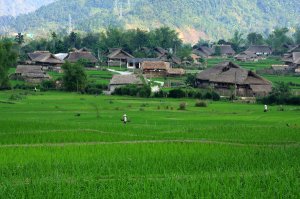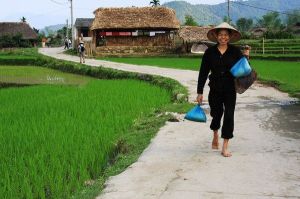With little background of visiting places in Vietnam, I didn’t expect much when joining the photo trip “Northern Vietnam Discovery” to Ha Giang and Dong Van located in the top north of the country. Just the stunning landscape and untouched beauty of the colorful weekly “minorities’ markets” would be enough to fulfill my journey. Unexpectedly and surprisingly, I found something even more rewarding and memorable than the spectacular scenery from this trip. It was the Tai; one of the 22 ethnic minorities originally living in Ha Giang who share values, traditions, language and roots in common with us “Thai” living in Thailand.
Home Stay at Mom’s Home (Bac Me), Ha Giang
Spending a day and night in the Tai village in Bac Me, a district in Ha Giang, was like taking a time machine back into the past to meet our living ancestors there. Thanks to fact that mass tourism has not arrived there yet, there was just one home stay in the community, so we could appreciate the unspoiled beauty of their simple way of life. Proudly, we later learned that we were the first group of Thais to have visited there. It was no wonder that it was not only us who felt excited to meet and chat in Thai with the locals, but so did they. The warm-hearted and friendly hospitality from the host and the villagers reminded me of a home coming on the Songkran holiday in the upcountry when I was very young, so we nicknamed that village “Ban Mae” – “Mom’s home” instead of its original name “Bac Me”.
(Ha Giang is the poor agricultural province where the Vietnamese is planning to build up factories in the future development)
Besides comfy clean accommodation and delicious Tai food provided by Are-Tan our kind host, the highlight of the stay was chatting and sharing the similar vocabulary used in Tai and Thai language. There are a lot of words found in common useage like numbers, colors, and body parts, names in family, greetings and things in nature. If we stayed in the village a couple of days longer, I believewe would be able to communicate perfectly in the same language.
(When asked “ Pai Nai – Where’re you going?” , this Tai women answered with a big smile “ Hed Wiead – Going to work”; the similar expression used in Lao and in the northern Thailand.)
In the late afternoon while trekking on the dirt road around the beautiful and peaceful villages and sitting in the green paddy fields by the foot of the mountains, we heard the friendly invitation from a man: “Nee Huen Nong, Pee Kin Nam” – “Sisters and brothers, this is my home. You’re welcome to stop by and have some drinking water.” His wife, who was cutting bamboo wood for a weaving on another side of the road, extended the same warm welcome to my friend: “Kuen Huen Kin Nam.” Surprisingly, I was so touched by his invitation that my eyes were almost in tears with a heartfelt thank you. It was exactly the same hospitality used to welcome visitors that we had at home in Thailand in the rural area.
(the owner of the house greets us in a very way Thai expression “Pai Nai?” and we told her “Pai Lah” in Tai, which mean “Pai Tieaw” in Thai or Look around.)
Getting to Ha Giang
The best way of getting to Ha Giang is by a chartered van with a guide from Hanoi. For more details you may check with a tour operator agency to buy a package tour of 6 days 5 nights from Hanoi. Ha Giang is in a remote area 320 km north of Ha Noi and still lacks full infrastructure and accommodation for mass tourism. The road condition in some part is difficult to get through due to a mountainous landscape. It takes longer than a full day and night to reach Bac Me, Ha Giang You can spend the first night in a resort in Haong Su Phi, surrounded by the terrace rice fields, where most of the workers there can chat with you in simple Thai words as they belong to either Tai, Tai Dum or Tai Lue. We found this out by chance with a big surprise, when one of the workers cried out “Pha Rong” – “ Thunder rumbling”. From then on we greeted locals whose looked like us in Thai, along the route until we reached Dong Van, the land of Hmong, in the farther north which will be the next town to visit.
(The farewell breakfast from our host. Look at the yellow sticky rice eating with salty minced dry pork! It’s the same treat the Thai eat at home.)
We hope you enjoy the pictures of Ha Giang; the province that is economically poor but rich in the cultures and traditions of the minorities’ ways of living.
———————————————
*Story and photo by Mawanta Tana, a seasoned traveller based in Bangkok.
The story was written for Mekong Media’s Voice :www.vmekongmedia.com





